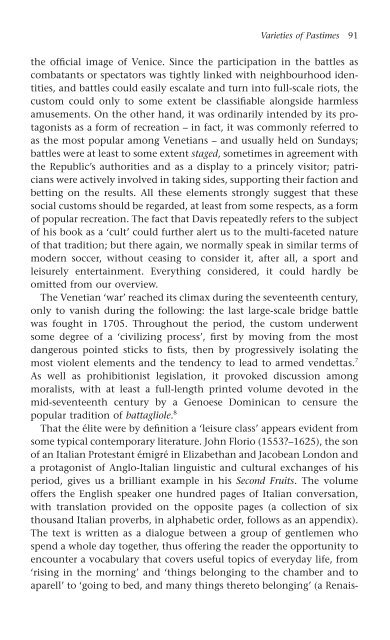Recreation in the Renaissance
Recreation in the Renaissance
Recreation in the Renaissance
- No tags were found...
You also want an ePaper? Increase the reach of your titles
YUMPU automatically turns print PDFs into web optimized ePapers that Google loves.
Varieties of Pastimes 91<br />
<strong>the</strong> official image of Venice. S<strong>in</strong>ce <strong>the</strong> participation <strong>in</strong> <strong>the</strong> battles as<br />
combatants or spectators was tightly l<strong>in</strong>ked with neighbourhood identities,<br />
and battles could easily escalate and turn <strong>in</strong>to full-scale riots, <strong>the</strong><br />
custom could only to some extent be classifiable alongside harmless<br />
amusements. On <strong>the</strong> o<strong>the</strong>r hand, it was ord<strong>in</strong>arily <strong>in</strong>tended by its protagonists<br />
as a form of recreation – <strong>in</strong> fact, it was commonly referred to<br />
as <strong>the</strong> most popular among Venetians – and usually held on Sundays;<br />
battles were at least to some extent staged, sometimes <strong>in</strong> agreement with<br />
<strong>the</strong> Republic’s authorities and as a display to a pr<strong>in</strong>cely visitor; patricians<br />
were actively <strong>in</strong>volved <strong>in</strong> tak<strong>in</strong>g sides, support<strong>in</strong>g <strong>the</strong>ir faction and<br />
bett<strong>in</strong>g on <strong>the</strong> results. All <strong>the</strong>se elements strongly suggest that <strong>the</strong>se<br />
social customs should be regarded, at least from some respects, as a form<br />
of popular recreation. The fact that Davis repeatedly refers to <strong>the</strong> subject<br />
of his book as a ‘cult’ could fur<strong>the</strong>r alert us to <strong>the</strong> multi-faceted nature<br />
of that tradition; but <strong>the</strong>re aga<strong>in</strong>, we normally speak <strong>in</strong> similar terms of<br />
modern soccer, without ceas<strong>in</strong>g to consider it, after all, a sport and<br />
leisurely enterta<strong>in</strong>ment. Everyth<strong>in</strong>g considered, it could hardly be<br />
omitted from our overview.<br />
The Venetian ‘war’ reached its climax dur<strong>in</strong>g <strong>the</strong> seventeenth century,<br />
only to vanish dur<strong>in</strong>g <strong>the</strong> follow<strong>in</strong>g: <strong>the</strong> last large-scale bridge battle<br />
was fought <strong>in</strong> 1705. Throughout <strong>the</strong> period, <strong>the</strong> custom underwent<br />
some degree of a ‘civiliz<strong>in</strong>g process’, first by mov<strong>in</strong>g from <strong>the</strong> most<br />
dangerous po<strong>in</strong>ted sticks to fists, <strong>the</strong>n by progressively isolat<strong>in</strong>g <strong>the</strong><br />
most violent elements and <strong>the</strong> tendency to lead to armed vendettas. 7<br />
As well as prohibitionist legislation, it provoked discussion among<br />
moralists, with at least a full-length pr<strong>in</strong>ted volume devoted <strong>in</strong> <strong>the</strong><br />
mid-seventeenth century by a Genoese Dom<strong>in</strong>ican to censure <strong>the</strong><br />
popular tradition of battagliole. 8<br />
That <strong>the</strong> élite were by def<strong>in</strong>ition a ‘leisure class’ appears evident from<br />
some typical contemporary literature. John Florio (1553–1625), <strong>the</strong> son<br />
of an Italian Protestant émigré <strong>in</strong> Elizabethan and Jacobean London and<br />
a protagonist of Anglo-Italian l<strong>in</strong>guistic and cultural exchanges of his<br />
period, gives us a brilliant example <strong>in</strong> his Second Fruits. The volume<br />
offers <strong>the</strong> English speaker one hundred pages of Italian conversation,<br />
with translation provided on <strong>the</strong> opposite pages (a collection of six<br />
thousand Italian proverbs, <strong>in</strong> alphabetic order, follows as an appendix).<br />
The text is written as a dialogue between a group of gentlemen who<br />
spend a whole day toge<strong>the</strong>r, thus offer<strong>in</strong>g <strong>the</strong> reader <strong>the</strong> opportunity to<br />
encounter a vocabulary that covers useful topics of everyday life, from<br />
‘ris<strong>in</strong>g <strong>in</strong> <strong>the</strong> morn<strong>in</strong>g’ and ‘th<strong>in</strong>gs belong<strong>in</strong>g to <strong>the</strong> chamber and to<br />
aparell’ to ‘go<strong>in</strong>g to bed, and many th<strong>in</strong>gs <strong>the</strong>reto belong<strong>in</strong>g’ (a Renais-










